Traditional Irish cuisine is essentially the food of the poor, consisting of simple, starchy and hearty meals prepared with few ingredients by people with limited means. This food is simple,connected to the land and prepared in primitive ways, such as boiling meat and potatoes.1
The Potato
The potato had a considerable amount of influence in Irish cuisine, for it provided a new staple food. To eat bread, one had to grow and cut the wheat, make the wheat into flour, cook the flour and bake it into bread. 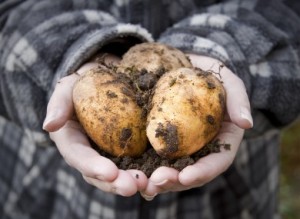 Compared to this complex process, one only had to boil or bake the potato in order to consume it. Potatoes were cheap and convenient, not to mention hearty. Nearly the perfect food, potatoes are loaded with protein, vitamins and complex carbohydrates. Infant mortality plummeted and the Irish grew bigger, stronger and healthier. Soon the Irish towered in physical stature over their rural English counterparts who subsisted on bread. From 1780 to 1840, the Irish population doubled, from 4 million to 8 million.1
Compared to this complex process, one only had to boil or bake the potato in order to consume it. Potatoes were cheap and convenient, not to mention hearty. Nearly the perfect food, potatoes are loaded with protein, vitamins and complex carbohydrates. Infant mortality plummeted and the Irish grew bigger, stronger and healthier. Soon the Irish towered in physical stature over their rural English counterparts who subsisted on bread. From 1780 to 1840, the Irish population doubled, from 4 million to 8 million.1
Potatoes & Politics
Perhaps the greatest example of an intrinsic relationships between politics and food is the Irish’s historic- and at times, tragic -connection to the potato. When the Spanish introduced it to the New World in the 16th century, the crop was originally a savior of sorts, becoming a low-cost food source for Irish peasants.
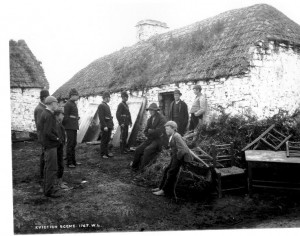
The agriculture in Ireland was highly developed, as peasants produced grain crops, such as wheat and barley, for the English. However, these crops were reserved for export, even when the blight decimated potato crops in the 1840s. As a result, the Irish Potato Famine, which lasted from 1845 to 1852, would claim approximately one million lives and lead to more than one million more emigrants fleeing Ireland. Aaron Hostetter, an assistant professor of English at Rutgers University-Camden, who examines the literary history of food, said, “The blight was a biological event, but famine and starvation are never natural events…The necessity to select certain kinds of food to eat – even when no other viable alternatives are available – is always politically motivated.”

The potato then becomes part of the Irish émigré identity. By wresting back the crop from failure, it is elevated to a symbol of victory over material circumstances.1There are many instances in which foods that are products of an oppressed identity become celebrated as symbols of resistance,” says Hostetter.
The Sophistication of the Spud
When the potatoes were first implemented in Europe, there weren’t “dishes”,so much as the bare minimum for survival. The ones who ate them were mostly ones who couldn’t
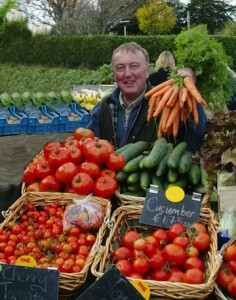
afford what was considered a “proper” meal; they were prepared in the most simple and easy methods to be readily eaten-merely boiled or baked. However, as the potatoes began to gain prominence in Europe, potato dishes began developing into modern delicacies.
Gourmet Ireland may sound like an oxymoron, but the fact is Ireland’s cuisine has risen to astonishing heights since the dreary day of the fifties and sixties where insipid, waterlogged veggies and fatty fried foods seemed to be the norm.2 By the eighties, a revolution was taking place all over Ireland with the newly gained popularity of food fairs, food festivals and gourmet markets.
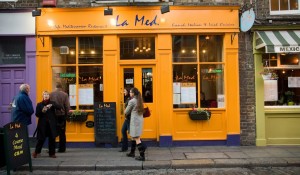
As Ireland’s economy expanded, so did the number of fine dining establishments. In Dublin, Patrick Guilbaud opened a new French restaurant bearing his name, a 2-star Michilin eatery.Others, like Kevin Thornton, fused classic Irish ingredients of beef and potatoes with the elaborate techniques of French cuisine. Thornton’s Pomme Mousseline is a very indulgent way to make mashed potatos, incorporating whisked cream for a lighter, richer version.
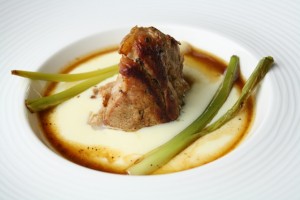
In fact, Kevin Thornton went so far as to “forcibly eject” a man from his restaurant, when the patron ordered chips. Thornton later explained that whilst chips were not on his menu, he often cooks them on special request for children. To some, Thornton was made out to look like a snobby chef, to others; however, he was an “uncompromising perfectionist”, who provided a “quality, value product, than a cheap compromise.”3 It is from the bare minimal preparation for survival, to the gourmet standard of urban restaurants, that the evolution of what are still traditional Irish ingredients can be observed. The potato itself is traditional, being prepared in a most contemporary and globally influenced way.
But not all restauranteurs were interested in expanding the repertory of French foods. Some chose traditional Irish dishes, creating them in new and updated ways. And that is precisely what the new Irish food is about. It is the old Irish food, updated with healthful preparation and keying on what is fresh and plentiful. Ireland is a land that excels in some of the world’s best dairy, fish and meat products.2
While Irish economy has suffered, along with many other countries in the global recession, the desire for fine cuisine has not. This is mainly because the standard for good ole’ fashioned Irish cooking is in the use of local ingredients. Some recipes show a regional influence, perhaps Asian or Mediterranean, but the basic dishes are Irish, and Irish at its best. When once visitors traveled to Ireland for the scenery, now they just might be going for the delicious food.2
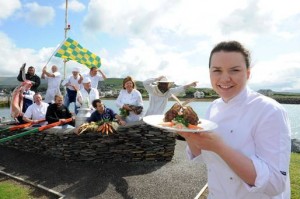
1) McLaughlin, Tom. “A Taste of Irish History.” Rutgers Today. 6 March 2014. Web.02 Dec. 2014.<http://news.rutgers.edu/feature/taste-irishhistory/20140306#.VH5Vfod-NUS>
2) Barrett, Suzanne. “Gourmet Ireland.” Ireland for Visitors. Web. 02 Dec. 2014.<http://www.irelandforvisitors.com/articles/gourmet_ireland.htm>
3)”NO WE DON’T DO CHIPS HERE! GET OUT!” Heffernan’s Tyre Blog. Web. 19 Nov. 2012. 02 Dec. 2014.http://heffernantyres.blogspot.com/2012/11/no-we-dont-do-chips-here-get-out.html>

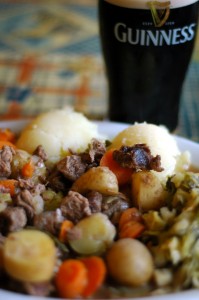
One Reply to “Ireland and the Potato”